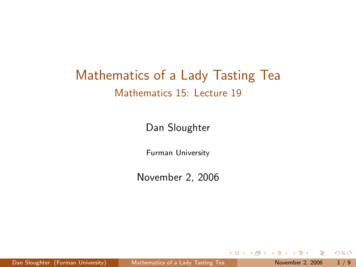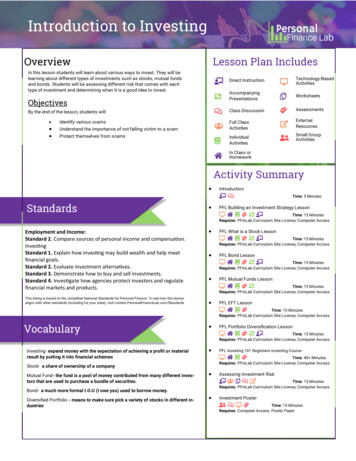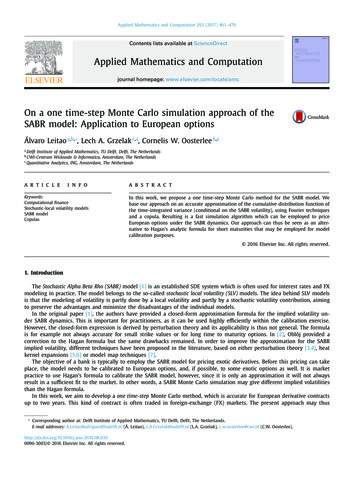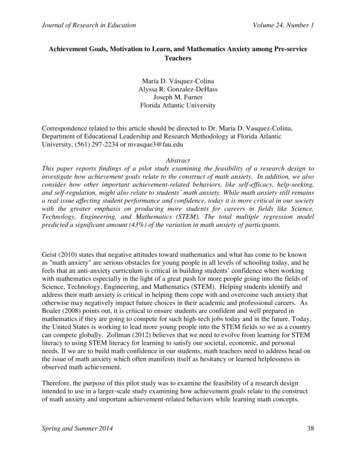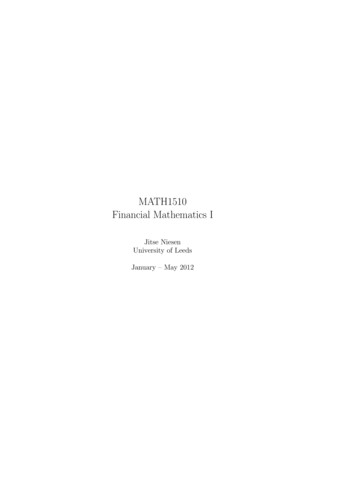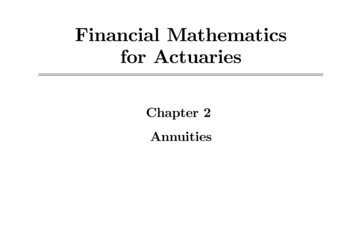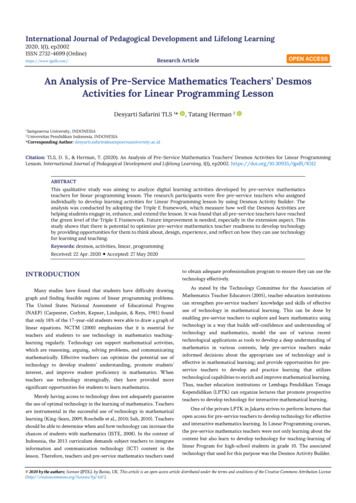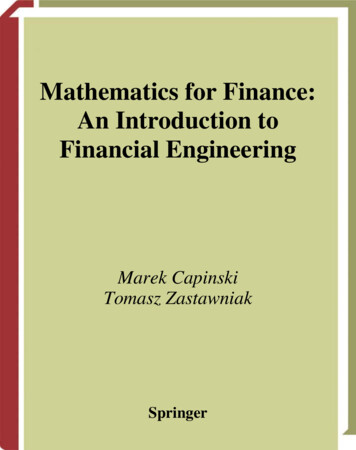
Transcription
Mathematics for Finance:An Introduction toFinancial EngineeringMarek CapinskiTomasz ZastawniakSpringer
Springer Undergraduate Mathematics SeriesSpringerLondonBerlinHeidelbergNew YorkHong KongMilanParisTokyo
Advisory BoardP.J. Cameron Queen Mary and Westfield CollegeM.A.J. Chaplain University of DundeeK. Erdmann Oxford UniversityL.C.G. Rogers University of CambridgeE. Süli Oxford UniversityJ.F. Toland University of BathOther books in this seriesA First Course in Discrete Mathematics I. AndersonAnalytic Methods for Partial Differential Equations G. Evans, J. Blackledge, P. YardleyApplied Geometry for Computer Graphics and CAD D. MarshBasic Linear Algebra, Second Edition T.S. Blyth and E.F. RobertsonBasic Stochastic Processes Z. Brzeźniak and T. ZastawniakElementary Differential Geometry A. PressleyElementary Number Theory G.A. Jones and J.M. JonesElements of Abstract Analysis M. Ó SearcóidElements of Logic via Numbers and Sets D.L. JohnsonEssential Mathematical Biology N.F. BrittonFields, Flows and Waves: An Introduction to Continuum Models D.F. ParkerFurther Linear Algebra T.S. Blyth and E.F. RobertsonGeometry R. FennGroups, Rings and Fields D.A.R. WallaceHyperbolic Geometry J.W. AndersonInformation and Coding Theory G.A. Jones and J.M. JonesIntroduction to Laplace Transforms and Fourier Series P.P.G. DykeIntroduction to Ring Theory P.M. CohnIntroductory Mathematics: Algebra and Analysis G. SmithLinear Functional Analysis B.P. Rynne and M.A. YoungsonMatrix Groups: An Introduction to Lie Group Theory A. BakerMeasure, Integral and Probability M. Capiński and E. KoppMultivariate Calculus and Geometry S. DineenNumerical Methods for Partial Differential Equations G. Evans, J. Blackledge, P. YardleyProbability Models J. HaighReal Analysis J.M. HowieSets, Logic and Categories P. CameronSpecial Relativity N.M.J. WoodhouseSymmetries D.L. JohnsonTopics in Group Theory G. Smith and O. TabachnikovaTopologies and Uniformities I.M. JamesVector Calculus P.C. Matthews
Marek Capiński and Tomasz ZastawniakMathematics forFinanceAn Introduction to Financial EngineeringWith 75 Figures1 Springer
Marek CapińskiNowy Sa cz School of Business–National Louis University, 33-300 Nowy Sa cz,ul. Zielona 27, PolandTomasz ZastawniakDepartment of Mathematics, University of Hull, Cottingham Road,Kingston upon Hull, HU6 7RX, UKCover illustration elements reproduced by kind permission of:Aptech Systems, Inc., Publishers of the GAUSS Mathematical and Statistical System, 23804 S.E. Kent-Kangley Road, Maple Valley, WA 98038,USA. Tel: (206) 432 - 7855 Fax (206) 432 - 7832 email: info@aptech.com URL: www.aptech.com.American Statistical Association: Chance Vol 8 No 1, 1995 article by KS and KW Heiner ‘Tree Rings of the Northern Shawangunks’ page 32fig 2.Springer-Verlag: Mathematica in Education and Research Vol 4 Issue 3 1995 article by Roman E Maeder, Beatrice Amrhein and Oliver Gloor‘Illustrated Mathematics: Visualization of Mathematical Objects’ page 9 fig 11, originally published as a CD ROM ‘Illustrated Mathematics’by TELOS: ISBN 0-387-14222-3, German edition by Birkhauser: ISBN 3-7643-5100-4.Mathematica in Education and Research Vol 4 Issue 3 1995 article by Richard J Gaylord and Kazume Nishidate ‘Traffic Engineering withCellular Automata’ page 35 fig 2. Mathematica in Education and Research Vol 5 Issue 2 1996 article by Michael Trott ‘The Implicitizationof a Trefoil Knot’ page 14.Mathematica in Education and Research Vol 5 Issue 2 1996 article by Lee de Cola ‘Coins, Trees, Bars and Bells: Simulation of the BinomialProcess’ page 19 fig 3. Mathematica in Education and Research Vol 5 Issue 2 1996 article by Richard Gaylord and Kazume Nishidate‘Contagious Spreading’ page 33 fig 1. Mathematica in Education and Research Vol 5 Issue 2 1996 article by Joe Buhler and Stan Wagon‘Secrets of theMadelung Constant’ page 50 fig 1.British Library Cataloguing in Publication DataCapiński, Marek, 1951Mathematics for finance : an introduction to financialengineering. - (Springer undergraduate mathematics series)1. Business mathematics 2. Finance – Mathematical modelsI. Title II. Zastawniak, Tomasz, 1959332’.0151ISBN 1852333308Library of Congress Cataloging-in-Publication DataCapiński, Marek, 1951Mathematics for finance : an introduction to financial engineering / Marek Capiński andTomasz Zastawniak.p. cm. — (Springer undergraduate mathematics series)Includes bibliographical references and index.ISBN 1-85233-330-8 (alk. paper)1. Finance – Mathematical models. 2. Investments – Mathematics. 3. Businessmathematics. I. Zastawniak, Tomasz, 1959- II. Title. III. Series.HG106.C36 2003332.6’01’51—dc212003045431Apart from any fair dealing for the purposes of research or private study, or criticism or review, as permittedunder the Copyright, Designs and Patents Act 1988, this publication may only be reproduced, stored or transmitted,in any form or by any means, with the prior permission in writing of the publishers, or in the case of reprographicreproduction in accordance with the terms of licences issued by the Copyright Licensing Agency. Enquiriesconcerning reproduction outside those terms should be sent to the publishers.Springer Undergraduate Mathematics Series ISSN 1615-2085ISBN 1-85233-330-8 Springer-Verlag London Berlin Heidelberga member of BertelsmannSpringer Science Business Media GmbHhttp://www.springer.co.uk Springer-Verlag London Limited 2003Printed in the United States of AmericaThe use of registered names, trademarks etc. in this publication does not imply, even in the absence of a specificstatement, that such names are exempt from the relevant laws and regulations and therefore free for general use.The publisher makes no representation, express or implied, with regard to the accuracy of the informationcontained in this book and cannot accept any legal responsibility or liability for any errors or omissions thatmay be made.Typesetting: Camera ready by the authors12/3830-543210 Printed on acid-free paper SPIN 10769004
PrefaceTrue to its title, this book itself is an excellent financial investment. For the priceof one volume it teaches two Nobel Prize winning theories, with plenty moreincluded for good measure. How many undergraduate mathematics textbookscan boast such a claim?Building on mathematical models of bond and stock prices, these two theories lead in different directions: Black–Scholes arbitrage pricing of options andother derivative securities on the one hand, and Markowitz portfolio optimisation and the Capital Asset Pricing Model on the other hand. Models based onthe principle of no arbitrage can also be developed to study interest rates andtheir term structure. These are three major areas of mathematical finance, allhaving an enormous impact on the way modern financial markets operate. Thistextbook presents them at a level aimed at second or third year undergraduatestudents, not only of mathematics but also, for example, business management,finance or economics.The contents can be covered in a one-year course of about 100 class hours.Smaller courses on selected topics can readily be designed by choosing theappropriate chapters. The text is interspersed with a multitude of worked examples and exercises, complete with solutions, providing ample material fortutorials as well as making the book ideal for self-study.Prerequisites include elementary calculus, probability and some linear algebra. In calculus we assume experience with derivatives and partial derivatives,finding maxima or minima of differentiable functions of one or more variables,Lagrange multipliers, the Taylor formula and integrals. Topics in probabilityinclude random variables and probability distributions, in particular the binomial and normal distributions, expectation, variance and covariance, conditional probability and independence. Familiarity with the Central Limit Theorem would be a bonus. In linear algebra the reader should be able to solvev
viMathematics for Financesystems of linear equations, add, multiply, transpose and invert matrices, andcompute determinants. In particular, as a reference in probability theory werecommend our book: M. Capiński and T. Zastawniak, Probability ThroughProblems, Springer-Verlag, New York, 2001.In many numerical examples and exercises it may be helpful to use a computer with a spreadsheet application, though this is not absolutely essential.Microsoft Excel files with solutions to selected examples and exercises are available on our web page at the addresses below.We are indebted to Nigel Cutland for prompting us to steer clear of aninaccuracy frequently encountered in other texts, of which more will be said inRemark 4.1. It is also a great pleasure to thank our students and colleagues fortheir feedback on preliminary versions of various chapters.Readers of this book are cordially invited to visit the web page below tocheck for the latest downloads and corrections, or to contact the authors. Yourcomments will be greatly appreciated.Marek Capiński and Tomasz ZastawniakJanuary 2003www.springer.co.uk/M4F
Contents1.Introduction: A Simple Market Model . . . . . . . . . . . . . . . . . . . . . . 11.1 Basic Notions and Assumptions . . . . . . . . . . . . . . . . . . . . . . . . . . . . 11.2 No-Arbitrage Principle . . . . . . . . . . . . . . . . . . . . . . . . . . . . . . . . . . . . 51.3 One-Step Binomial Model . . . . . . . . . . . . . . . . . . . . . . . . . . . . . . . . . 71.4 Risk and Return . . . . . . . . . . . . . . . . . . . . . . . . . . . . . . . . . . . . . . . . . 91.5 Forward Contracts . . . . . . . . . . . . . . . . . . . . . . . . . . . . . . . . . . . . . . . . 111.6 Call and Put Options . . . . . . . . . . . . . . . . . . . . . . . . . . . . . . . . . . . . . 131.7 Managing Risk with Options . . . . . . . . . . . . . . . . . . . . . . . . . . . . . . . 192.Risk-Free Assets . . . . . . . . . . . . . . . . . . . . . . . . . . . . . . . . . . . . . . . . . . . .2.1 Time Value of Money . . . . . . . . . . . . . . . . . . . . . . . . . . . . . . . . . . . . .2.1.1 Simple Interest . . . . . . . . . . . . . . . . . . . . . . . . . . . . . . . . . . . . .2.1.2 Periodic Compounding . . . . . . . . . . . . . . . . . . . . . . . . . . . . . .2.1.3 Streams of Payments . . . . . . . . . . . . . . . . . . . . . . . . . . . . . . .2.1.4 Continuous Compounding . . . . . . . . . . . . . . . . . . . . . . . . . . .2.1.5 How to Compare Compounding Methods . . . . . . . . . . . . . .2.2 Money Market . . . . . . . . . . . . . . . . . . . . . . . . . . . . . . . . . . . . . . . . . . .2.2.1 Zero-Coupon Bonds . . . . . . . . . . . . . . . . . . . . . . . . . . . . . . . .2.2.2 Coupon Bonds . . . . . . . . . . . . . . . . . . . . . . . . . . . . . . . . . . . . .2.2.3 Money Market Account . . . . . . . . . . . . . . . . . . . . . . . . . . . . .21212224293235393941433.Risky Assets . . . . . . . . . . . . . . . . . . . . . . . . . . . . . . . . . . . . . . . . . . . . . . . .3.1 Dynamics of Stock Prices . . . . . . . . . . . . . . . . . . . . . . . . . . . . . . . . . .3.1.1 Return . . . . . . . . . . . . . . . . . . . . . . . . . . . . . . . . . . . . . . . . . . . .3.1.2 Expected Return . . . . . . . . . . . . . . . . . . . . . . . . . . . . . . . . . . .3.2 Binomial Tree Model . . . . . . . . . . . . . . . . . . . . . . . . . . . . . . . . . . . . . .4747495355vii
viiiContents3.2.13.2.23.3 Other3.3.13.3.2Risk-Neutral Probability . . . . . . . . . . . . . . . . . . . . . . . . . . . .Martingale Property . . . . . . . . . . . . . . . . . . . . . . . . . . . . . . . .Models . . . . . . . . . . . . . . . . . . . . . . . . . . . . . . . . . . . . . . . . . . . .Trinomial Tree Model . . . . . . . . . . . . . . . . . . . . . . . . . . . . . . .Continuous-Time Limit . . . . . . . . . . . . . . . . . . . . . . . . . . . . .58616364664.Discrete Time Market Models . . . . . . . . . . . . . . . . . . . . . . . . . . . . . .4.1 Stock and Money Market Models . . . . . . . . . . . . . . . . . . . . . . . . . . .4.1.1 Investment Strategies . . . . . . . . . . . . . . . . . . . . . . . . . . . . . . .4.1.2 The Principle of No Arbitrage . . . . . . . . . . . . . . . . . . . . . . .4.1.3 Application to the Binomial Tree Model . . . . . . . . . . . . . . .4.1.4 Fundamental Theorem of Asset Pricing . . . . . . . . . . . . . . .4.2 Extended Models . . . . . . . . . . . . . . . . . . . . . . . . . . . . . . . . . . . . . . . . .737375798183855.Portfolio Management . . . . . . . . . . . . . . . . . . . . . . . . . . . . . . . . . . . . . . 915.1 Risk . . . . . . . . . . . . . . . . . . . . . . . . . . . . . . . . . . . . . . . . . . . . . . . . . . . . 915.2 Two Securities . . . . . . . . . . . . . . . . . . . . . . . . . . . . . . . . . . . . . . . . . . . 945.2.1 Risk and Expected Return on a Portfolio . . . . . . . . . . . . . . 975.3 Several Securities . . . . . . . . . . . . . . . . . . . . . . . . . . . . . . . . . . . . . . . . . 1075.3.1 Risk and Expected Return on a Portfolio . . . . . . . . . . . . . . 1075.3.2 Efficient Frontier . . . . . . . . . . . . . . . . . . . . . . . . . . . . . . . . . . . 1145.4 Capital Asset Pricing Model . . . . . . . . . . . . . . . . . . . . . . . . . . . . . . . 1185.4.1 Capital Market Line . . . . . . . . . . . . . . . . . . . . . . . . . . . . . . . . 1185.4.2 Beta Factor . . . . . . . . . . . . . . . . . . . . . . . . . . . . . . . . . . . . . . . . 1205.4.3 Security Market Line . . . . . . . . . . . . . . . . . . . . . . . . . . . . . . . 1226.Forward and Futures Contracts . . . . . . . . . . . . . . . . . . . . . . . . . . . . . 1256.1 Forward Contracts . . . . . . . . . . . . . . . . . . . . . . . . . . . . . . . . . . . . . . . . 1256.1.1 Forward Price . . . . . . . . . . . . . . . . . . . . . . . . . . . . . . . . . . . . . . 1266.1.2 Value of a Forward Contract . . . . . . . . . . . . . . . . . . . . . . . . . 1326.2 Futures . . . . . . . . . . . . . . . . . . . . . . . . . . . . . . . . . . . . . . . . . . . . . . . . . 1346
of one volume it teaches two Nobel Prize winning theories, with plenty more included for good measure. How many undergraduate mathematics textbooks can boast such a claim? Building on mathematical models of bond and stock prices, these two theo-ries lead in different directions: Black–Scholes arbitrage pricing of options and other derivative securities on the one hand, and Markowitz .

